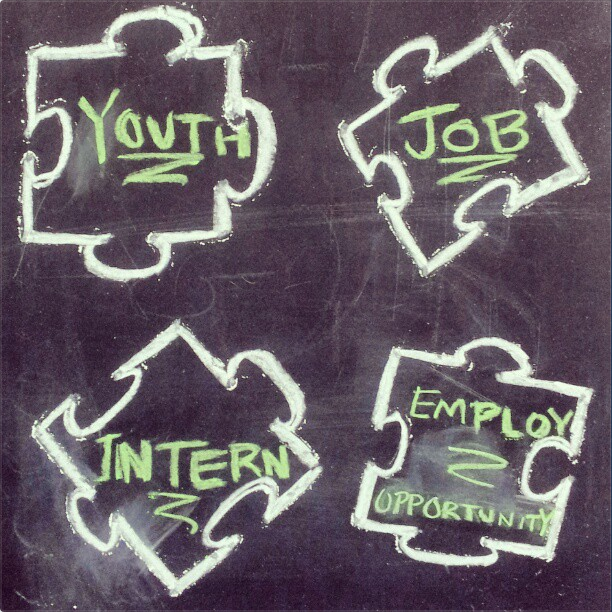“First off, we have to get them to believe in themselves, it’s not just to give them soft skills, resume building, it’s also to get them to like themselves,” said Jamie Fountain of Larkin Street Youth Services.
When we think of the unemployment rate, job searching, and interviewing, I often think of the college graduate fighting a tough economy. What we sometimes forget to think about is the thousands of unemployed youth across the country. And many of the youth aren’t just up against a tough job market, but also carry the burdens of homelessness, low income, and lack of education.
I spoke with Jamie Fountain, Workforce Development Manager at Larkin Street Youth Services and Jodi Schwartz, Executive Director at the Lavender Youth Recreation and Information Center, both based in San Francisco. Larkin Street and LYRIC have programs to help not only develop career skills, but also connect the youth to career opportunities.

Before connecting the youth to an internship or job, each program offers multi-step career training programs to help develop the skills of their youth.
Primarily LGBT, LYRIC focuses on developing their young people on the path to a career in social justice. For LYRIC’s “In the City Internship,” they take a very hands-on approach to job training, allowing them to organize their own events, budgets, and many other job related tasks to gain traditional job experience.
“What we really find effective with our young people is that they’re constantly learning then applying, learning then applying; we call it thematic learning.”
The young people that attend LYRIC are given the opportunity to manage a project, including managing the budget, building teams and committees, and learning how to market and do outreach. Because of the experience LYRIC youth gain through this program, they are better prepared and connected to opportunities in the social justice field. After going through the programs, many participants transition to either fulltime staff of LYRIC, or are hired to similar organizations.
Larkin Street takes a multi-facetted approach to career development, offering multi-step programs with participants ranging in age from 12 to 24. This includes Job Readiness Class, where they find out what they want to do, while developing soft skills in interviewing and job searching.
The Youth are then paired with a job counselor to further develop those skills, or have the opportunity to go to the Institute for Hire Learning, where they are connected to internships with local businesses and organizations. With over 47 sites in the Bay Area, the internships not only give work experience to youths, but also host and mentor them, developing a diverse number of skills in the work place.
One problem with connecting the youth to jobs lies in their own self esteem. Fountain says that it is so important for the youth to believe in themselves, and to show them that they are capable of entering the professional world.
“They need to first learn to love and accept themselves. We need to get them to see that they are special, and that they are intelligent.”
Fountain says that often times, he is able to show the youth that they have developed skills that they might not know about. Whatever these skills are, they can be transfered to the workplace.
“Some of our young people were involved in street life. So they say, “I’ve never worked.” I ask them how they got the money. “Oh I dabbled in street life. And I ask them if they sold a product. ‘Yeah.’ And I ask them if they were good at it. ‘Well, yeah.’ And I ask them if they had customer complaints, inventory issues, cost control. ‘Yeah.’ And I tell them, that’s business…These are transferable skills. Anything you’ve done, that you were successful at, in any shape or form, is a transferable skill.”
So what is the biggest challenge for the youth in terms of connecting them to job opportunities? It starts with what Schwartz calls, “The Triangle of Need.”
“Housing, mental and physical health, and a job. And if any of those three legs of the stool are shaky, the whole thing tumbles down.”
In order to find employment, youth need both a stable living arrangement and stable healthcare. Once stable living and health is secure, the youth can be better prepared to enter the job market, and employment opportunities arise. Whether it be developing skills within the program, or being connected to outside internships and mentorships, these youth organizations are opening the doors.
However, the youth organizations are only one part of the equation for connecting youth to job opportunities. The private sector businesses and organizations that offer internships and mentorships to the youth are also an important factor. Giving the youth a hands on opportunity to further develop career skills is important to the overall goal of youth employment.
Many of the young people at LYRIC have been marginalized from education and any kind of job training. Schwartz said that the youth social service network cannot support youth employment alone, and needs the support of the corporate sector.
“While we can get them through our job readiness program, they still need a lot of support once they arrive at the doorstep of their new job,” said Schwartz.
LYRIC and Larkin Street Youth Services are two of the youth organizations in San Francisco that are guiding young people on the path to satisfying work. To reduce unemployment, support the youth organizations that open doors to employment.












